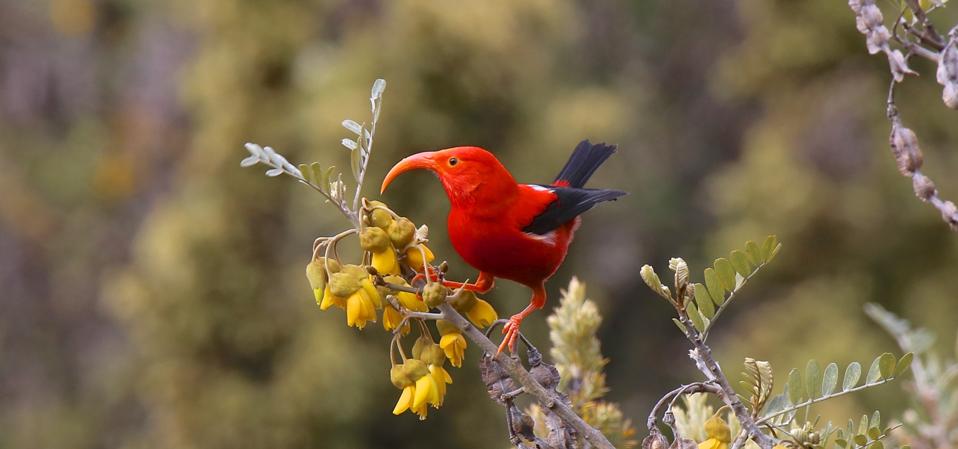There are few things in life worse than being a bird in Hawaii. Of the 142 avian species endemic to the islands, 95 have disappeared without a trace since the first humans arrived.
Of those left behind, 33 species have a spot on the endangered list. And for some Hawaiian honeycreepers, even our best efforts may be too little in the face of looming extinction. Here are three whose very existence is under extreme threat today.
1. ʻAkekeʻe (Loxops caeruleirostris)
At one time, the forests of Kaua‘i echoed with the soft trills of the ʻAkekeʻe. This bright greenish-yellow honeycreeper, found nowhere else on Earth, once ranged widely across the island’s highland forests, using its unique crossed bill to pry open buds in search of insects.
Today, its entire world has shrunk to the cool, misty canopy of the Alakaʻi Plateau. With fewer than 638 individuals left in 2021 and a massive decline seen over the years, the ʻAkekeʻe faces one of the steepest slides toward extinction of any Hawaiian bird.
The primary culprit is avian malaria. Introduced through mosquitoes that first reached the island in the 1800s, climate change has now ushered these deadly vessels of destruction into the bird’s last stronghold.
Compounding the crisis are habitat loss, invasive predators and the spread of Rapid ʻŌhiʻa Death, a fungal disease devastating the very trees the bird depends on.
Captive breeding efforts have begun, but the ʻAkekeʻe has proven reluctant to reproduce under human care. In 2022, the state turned to landscape-scale mosquito control using Wolbachia-infected males as a form of biological “birth control” in hopes of buying the species more time. But with funding from the Bipartisan Infrastructure Law currently in limbo, the future of the program remains uncertain.
The U.S. Fish & Wildlife Service has predicted that this bird could vanish from the wild by 2028.
2. Maui Parrotbill (Pseudonestor xanthophrys)
The Maui parrotbill, or kiwikiu, is a stout-billed songbird once widespread across Maui and Moloka‘i. This colorful honeycreeper now clings to survival in a sliver of rainforest on the windward slopes of Haleakalā. Fossil evidence tells us this bird once roamed the dry lowlands of these islands.
Today, it occupies 11 square miles of habitat — one that continues to shrink.
While avian malaria is a shared threat among Hawaii’s honeycreepers, the Maui parrotbill faces an even broader crisis. Generations of habitat loss, deforestation for agriculture and the spread of invasive plants and predators have reshaped its world.
Feral pigs, which once roamed the land and turned forests into mosquito breeding grounds, are largely gone from fenced areas. But rats remain, silently preying on nests. Nest failures are common after heavy rainfall, and the bird’s slow reproductive cycle, where a single chick is born every year, offers little room for error.
A 2019 translocation effort, aimed at establishing a second population on the leeward slopes of Haleakalā, ended in tragedy. All but one bird died or disappeared before they could establish. Now, conservationists are pivoting by building a new captive population in facilities across Hawaii and the mainland U.S. with the hope that avian malaria can be contained in the near future.
With an estimated wild population that may now be under 150, the clock is ticking. According to U.S. Fish & Wildlife Service estimates, the Maui parrotbill is predicted to go extinct by 2027.
3. ʻĀkohekohe (Palmeria dolei)
With a flamboyant crest and flame-orange streaks lighting up its black plumage, the ʻĀkohekohe was once a common sight across Maui and Molokaʻi. Today, this charismatic honeycreeper survives only in the misty mountain top forests of East Maui, confined to the highest ridgelines of Haleakalā.
It’s estimated that around 1,600 individuals remain, and even that may be optimistic.
Like its close cousins, the ʻĀkohekohe is highly vulnerable to avian malaria, which now creeps upward into its last strongholds. But the challenges don’t end there.
Its fate is also tied to the survival of the ʻōhiʻa tree, a keystone of Hawaiian forests and the bird’s preferred source of nectar. Rapid ʻŌhiʻa Death has devastated ʻōhiʻa forests elsewhere in Hawaii, and although Maui has mostly been spared, warmer temperatures could bring the pathogen uphill.
Unlike some other honeycreepers, the ʻĀkohekohe does not breed easily in captivity. A trial effort in the 1990s failed to produce a viable population, leaving no current backup in human care.
Its loud calls still echo across Waikamoi and Hanawi, but as per the U.S. Fish & Wildlife Service, the ʻĀkohekohe might go extinct by 2032.
As these beautiful honeycreepers inch closer to extinction, how do you feel about the debilitating effects of climate change? Take a 2-minute test to see where you stand on the Climate Change Worry Scale.

